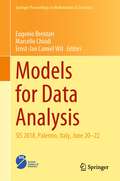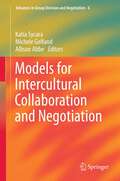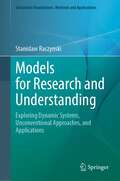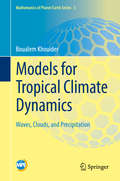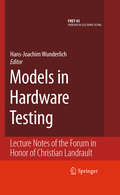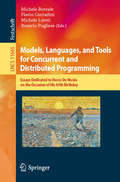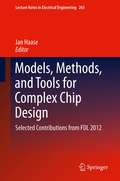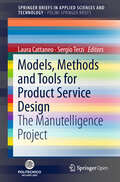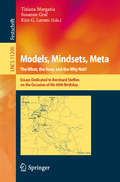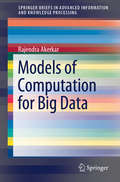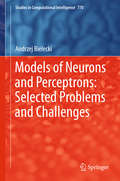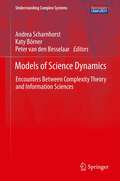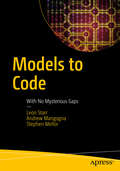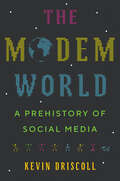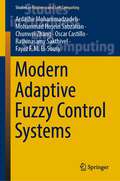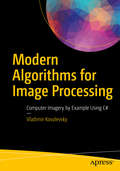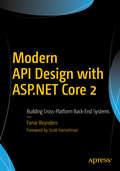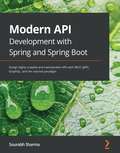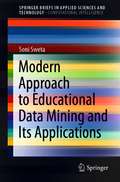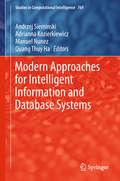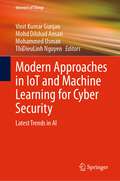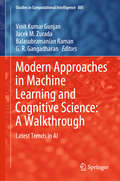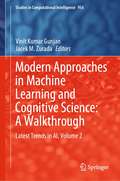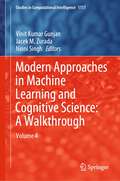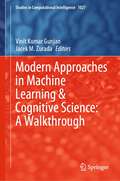- Table View
- List View
Models for Data Analysis: SIS 2018, Palermo, Italy, June 20–22 (Springer Proceedings in Mathematics & Statistics #402)
by Eugenio Brentari Marcello Chiodi Ernst-Jan Camiel WitThe 49Th Scientific meeting of the Italian Statistical Society was held in June 2018 in Palermo, with more than 450 attendants. There were plenary sessions as well as specialized and solicited and contributed sessions.This volume collects a selection of twenty extended contributions covering a wide area of applied and theoretical issues, according to the modern trends in statistical sciences. Only to mention some topics, there are papers on modern textual analysis, sensorial analysis, social inequalities, themes on demography, modern modeling of functional data and high dimensional data, and many other topics.This volume is addressed to academics, PhD students, professionals and researchers in applied and theoretical statistical models for data analysis.
Models for Intercultural Collaboration and Negotiation
by Katia Sycara Michele Gelfand Allison AbbeThis book is the first to bring together research material from different communities, Computer Science and especially Artificial Intelligence, and Social Sciences, e.g. Anthropology, Social Psychology, Political Science that present ideas and viewpoints, methods and models on inter-cultural collaboration and negotiation. With increasing globalization of business and science, cultural differences of the parties are an important factor that affects the process and outcomes of collaborative and self-interested interactions. The social science literature on culture as well as human collaboration and negotiation is vast. Most of this literature is devoted to work within the same culture. Artificial intelligence researchers, on the other hand, have developed computational models of cooperation, conflict resolution and negotiation, but paying almost no attention to identifying and modeling cultural factors. In recent years, we have witnessed a great increase in interest in understanding inter-cultural interactions. This has led to increased interest of social scientists and computational scientists in theoretical and experimental analysis of inter-cultural exchanges, modeling and support. Currently, these communities are largely unconnected. There is a great need to bring them together to share research work and experiences, discuss ideas and forge interdisciplinary collaborative relations. This book will be of interest to researchers from AI/computer science and social/behavioral sciences fields, such as psychology, sociology, communications, organizational science.
Models for Research and Understanding: Exploring Dynamic Systems, Unconventional Approaches, and Applications (Simulation Foundations, Methods and Applications)
by Stanislaw RaczynskiThis introductory textbook/reference addresses the fundamental and mostly applied kinds of models. The focus is on models of dynamic systems that move and change over time. However, the work also proposes new methods of uncertainty treatment, offering supporting examples.Topics and features: Chapters suitable for textbook use in teaching modeling and simulationIncludes sections of questions and answers, helpful in didactic workProposes new methodology in addition to examining conventional approachesOffers some cognitive, more abstract models to give a wider insight on model building The book’s readership may consist of researchers working on multidisciplinary problems, as well educators and students. It may be used while teaching computer simulation, applied mathematics, system analysis and system dynamics.
Models for Tropical Climate Dynamics: Waves, Clouds, and Precipitation (Mathematics of Planet Earth #3)
by Boualem KhouiderThis book is a survey of the research work done by the author over the last 15 years, in collaboration with various eminent mathematicians and climate scientists on the subject of tropical convection and convectively coupled waves. In the areas of climate modelling and climate change science, tropical dynamics and tropical rainfall are among the biggest uncertainties of future projections. This not only puts at risk billions of human beings who populate the tropical continents but it is also of central importance for climate predictions on the global scale. This book aims to introduce the non-expert readers in mathematics and theoretical physics to this fascinating topic in order to attract interest into this difficult and exciting research area. The general thyme revolves around the use of new deterministic and stochastic multi-cloud models for tropical convection and convectively coupled waves. It draws modelling ideas from various areas of mathematics and physics and used in conjunction with state-of-the-art satellite and in-situ observations and detailed numerical simulations. After a review of preliminary material on tropical dynamics and moist thermodynamics, including recent discoveries based on satellite observations as well as Markov chains, the book immerses the reader into the area of models for convection and tropical waves. It begins with basic concepts of linear stability analysis and ends with the use of these models to improve the state-of-the-art global climate models. The book also contains a fair amount of exercises that makes it suitable as a textbook complement on the subject.
Models in Hardware Testing
by Hans-Joachim WunderlichModel based testing is the most powerful technique for testing hardware and software systems. Models in Hardware Testing describes the use of models at all the levels of hardware testing. The relevant fault models for nanoscaled CMOS technology are introduced, and their implications on fault simulation, automatic test pattern generation, fault diagnosis, memory testing and power aware testing are discussed. Models and the corresponding algorithms are considered with respect to the most recent state of the art, and they are put into a historical context by a concluding chapter on the use of physical fault models in fault tolerance.
Models, Languages, and Tools for Concurrent and Distributed Programming: Essays Dedicated to Rocco De Nicola on the Occasion of His 65th Birthday (Lecture Notes in Computer Science #11665)
by Michele Boreale Flavio Corradini Michele Loreti Rosario PuglieseThis volume was published in honor of Rocco De Nicola’s 65th birthday. The Festschrift volume contains 27 papers written by close collaborators and friends of Rocco De Nicola and was presented to Rocco on the 1st of July 2019 during a two-day symposium held in Lucca, Italy. The papers present many research ideas that have been influenced by Rocco's work. They testify his intellectual curiosity, versatility and tireless research activity, and provide an overview of further developments to come. The volume consists of six sections. The first one contains a laudation illustrating the distinguished career and the main scientific contributions by Rocco and a witness of working experiences with Rocco. The remaining five sections comprise scientific papers related to specific research interests of Rocco and are ordered according to his scientific evolution: Observational Semantics; Logics and Types; Coordination Models and Languages; Distributed Systems Modelling; Security.
Models, Methods, and Tools for Complex Chip Design
by Jan HaaseThis book brings together a selection of the best papers from the fifteenth edition of the Forum on specification and Design Languages Conference (FDL), which was held in September 2012 at Vienna University of Technology, Vienna, Austria. FDL is a well-established international forum devoted to dissemination of research results, practical experiences and new ideas in the application of specification, design and verification languages to the design, modeling and verification of integrated circuits, complex hardware/software embedded systems, and mixed-technology systems.
Models, Methods and Tools for Product Service Design: The Manutelligence Project (SpringerBriefs in Applied Sciences and Technology)
by Sergio Terzi Laura CattaneoThis open access book summarizes research being pursued within the Manutelligence project, the goal of which is to help enterprises develop smart, social and flexible products with high value added services. Manutelligence has improved Product and Service Design by developing suitable models and methods, and connecting them through a modular, collaborative and secure ICT Platform. The use of real data collected in real time by Internet of Things (IoT) technologies underpins the design of product-service systems and makes it possible to monitor them throughout their life cycle. Available data allows costs and sustainability issues to be more accurately measured and simulated in the form of Life Cycle Cost (LCC) and Life Cycle Assessment (LCA). Analysing data from IoT systems and sharing LCC and LCA information via the ICT Platform can help to accelerate the design of product-service systems, reduce costs and better understand customer needs. Industrial partners involved in Manutelligence provide a clear overview of the project’s outcomes, and demonstrate how its technological solutions can be used to improve the design of product-service systems and the management of product-service life cycles.
Models, Mindsets, Meta: Essays Dedicated to Bernhard Steffen on the Occasion of His 60th Birthday (Lecture Notes in Computer Science #11200)
by Tiziana Margaria Susanne Graf Kim G. LarsenThis Festschrift volume is published in honor of Bernhard Steffen, Professor at the Technical University of Dortmund, on the occasion of his 60th birthday. His vision as well as his theoretical and practical work span the development and implementation of novel, specific algorithms, and the establishment of cross-community relationships with the effect to obtain simpler, yet more powerful solutions. He initiated many new lines of research through seminal papers that pioneered various fields, starting with the Concurrency Workbench, a model checking toolbox that significantly influenced the research and development of mode based high assurance systems worldwide. The contributions in this volume reflect the breadth and impact of his work. The introductory paper by the volume editors, the 23 full papers and two personal statements relate to Bernhard’s research and life. This volume, the talks and the entire B-Day at ISoLA 2018 are a tribute to the first 30 years of Bernhard’s passion, impact and vision for many facets of computer science in general and for formal methods in particular. Impact and vision include the many roles that formal methods-supported software development should play in education, in industry and in society.
Models of Computation for Big Data (Advanced Information and Knowledge Processing)
by Rajendra AkerkarThe big data tsunami changes the perspective of industrial and academic research in how they address both foundational questions and practical applications. This calls for a paradigm shift in algorithms and the underlying mathematical techniques. There is a need to understand foundational strengths and address the state of the art challenges in big data that could lead to practical impact. The main goal of this book is to introduce algorithmic techniques for dealing with big data sets. Traditional algorithms work successfully when the input data fits well within memory. In many recent application situations, however, the size of the input data is too large to fit within memory. Models of Computation for Big Data, covers mathematical models for developing such algorithms, which has its roots in the study of big data that occur often in various applications. Most techniques discussed come from research in the last decade. The book will be structured as a sequence of algorithmic ideas, theoretical underpinning, and practical use of that algorithmic idea. Intended for both graduate students and advanced undergraduate students, there are no formal prerequisites, but the reader should be familiar with the fundamentals of algorithm design and analysis, discrete mathematics, probability and have general mathematical maturity.
Models of Neurons and Perceptrons: Selected Problems and Challenges (Studies In Computational Intelligence #770)
by Andrzej BieleckiThis book describes models of the neuron and multilayer neural structures, with a particular focus on mathematical models. It also discusses electronic circuits used as models of the neuron and the synapse, and analyses the relations between the circuits and mathematical models in detail. The first part describes the biological foundations and provides a comprehensive overview of the artificial neural networks. The second part then presents mathematical foundations, reviewing elementary topics, as well as lesser-known problems such as topological conjugacy of dynamical systems and the shadowing property. The final two parts describe the models of the neuron, and the mathematical analysis of the properties of artificial multilayer neural networks. Combining biological, mathematical and electronic approaches, this multidisciplinary book it useful for the mathematicians interested in artificial neural networks and models of the neuron, for computer scientists interested in formal foundations of artificial neural networks, and for the biologists interested in mathematical and electronic models of neural structures and processes.
Models of Science Dynamics
by Peter Van Besselaar Andrea Scharnhorst Katy BörnerModels of Science Dynamics aims to capture the structure and evolution of science, the emerging arena in which scholars, science and the communication of science become themselves the basic objects of research. In order to capture the essence of phenomena as diverse as the structure of co-authorship networks or the evolution of citation diffusion patterns, such models can be represented by conceptual models based on historical and ethnographic observations, mathematical descriptions of measurable phenomena, or computational algorithms. Despite its evident importance, the mathematical modeling of science still lacks a unifying framework and a comprehensive study of the topic. This volume fills this gap, reviewing and describing major threads in the mathematical modeling of science dynamics for a wider academic and professional audience. The model classes presented cover stochastic and statistical models, system-dynamics approaches, agent-based simulations, population-dynamics models, and complex-network models. The book comprises an introduction and a foundational chapter that defines and operationalizes terminology used in the study of science, as well as a review chapter that discusses the history of mathematical approaches to modeling science from an algorithmic-historiography perspective. It concludes with a survey of remaining challenges for future science models and their relevance for science and science policy.
Models to Code
by Leon Starr Andrew Mangogna Stephen MellorLearn how to translate an executable model of your application into running code. This is not a book about theory, good intentions or possible future developments. You'll benefit from translation technology and solid software engineering principles that are demonstrated with concrete examples using an open source tool chain. Models don't deliver enough value if they are not on a direct path to code production. But to waste time building models that are merely pictures of your code doesn't add much value either. In this book, you'll translate detailed, yet platform-independent models that solve real application problems. Using a pragmatic approach, Models to Code quickly dives into two case studies of Executable UML models. The models and code are extensively annotated and illustrate key principles that are emphasized throughout the book. You'll work with code production using "C" as the implementation language and targeting microcomputer class processors. This might not be your particular target language or platform, but you can use you can use what you learn here to engineer or re-evaluate your own code translation system to dramatically increase the value of both your modeling and code generation solution. Written by three leading experts, Models to Code is an exceptional resource for producing software by model translation-- add it to your library today. What You'll Learn See how detailed models resolve ambiguity and contradiction common in requirements. Examine how a model can be detailed enough to be executable and testable while remaining platform independent Produce code from a model, leaving the model intact so it can be redeployed on new platforms or adapted to changing software and hardware technology. Implement platform independent model execution rules in platform specific run-time code Who This Book Is For Modelers and systems engineers on active MBSE projects (using Executable UML or not), projects using Simulink, Matlab, Dymola, MatrixX and other math modelling tools. Any developers with current or past model experience, professors, students, systems engineers, embedded systems developers, or anyone interested in learning more about software modelling.
The Modem World: A Prehistory of Social Media
by Kevin DriscollThe untold story about how the internet became social, and why this matters for its future &“A great book for anyone who wants to understand the early days of online communications.&”—Preston Gralla, Arts Fuse Fifteen years before the commercialization of the internet, millions of amateurs across North America created more than 100,000 small-scale computer networks. The people who built and maintained these dial-up bulletin board systems (BBSs) in the 1980s laid the groundwork for millions of others who would bring their lives online in the 1990s and beyond. From ham radio operators to HIV/AIDS activists, these modem enthusiasts developed novel forms of community moderation, governance, and commercialization. The Modem World tells an alternative origin story for social media, centered not in the office parks of Silicon Valley or the meeting rooms of military contractors, but rather on the online communities of hobbyists, activists, and entrepreneurs. Over time, countless social media platforms have appropriated the social and technical innovations of the BBS community. How can these untold stories from the internet&’s past inspire more inclusive visions of its future?
Modern Adaptive Fuzzy Control Systems (Studies in Fuzziness and Soft Computing #421)
by Ardashir Mohammadzadeh Mohammad Hosein Sabzalian Chunwei Zhang Oscar Castillo Rathinasamy Sakthivel Fayez F. El-SousyThis book explains the basic concepts, theory and applications of fuzzy systems in control in a simple unified approach with clear ex-amples and simulations in the MATLAB programming language. Fuzzy systems, especially, type-2 neuro-fuzzy systems, are now used extensively in various engineering fields for different purposes. In plain language, this book aims to practically explain fuzzy sys-tems and different methods of training and optimizing these systems. For this purpose, type-2 neuro-fuzzy systems are first analyzed along with various methods of training and optimizing these systems through implementation in MATLAB. These systems are then em-ployed to design adaptive fuzzy controllers. The authors aim at pre-senting all the well-known optimization methods clearly and code them in the MATLAB language.
Modern Algorithms for Image Processing: Computer Imagery by Example Using C#
by Vladimir Kovalevsky<p>Utilize modern methods for digital image processing and take advantage of the many time-saving templates provided for all of the projects in this book. <p>Modern Algorithms for Image Processing approaches the topic of image processing through teaching by example. Throughout the book, you will create projects that resolve typical problems that you might encounter in the world of digital image processing. Some projects teach you methods for addressing the quality of images, such as reducing random errors or noise and suppressing pulse noise (salt and pepper), a method valuable for improving the quality of historical images. Other methods detail how to correct inhomogeneous illumination, not by means of subtracting the mean illumination, but through division, a far more efficient method. Additional projects cover contrasting, and a process for edge detection, more efficient than Canny's, for detecting edges in color images directly, without converting them into black and white images. <p>What You'll Learn: <p> <li>Apply innovative methods for suppressing pulse noise, enhancing contrast, and edge detection <li>Know the pros and cons of enlisting a particular method <li>Use new approaches for image compression and recognizing circles in photos <li>Utilize a valuable method for straightening photos of paintings taken at an oblique angle, a critical concept to understand when using flash at a right angle <li>Understand the problem statement of polygonal approximation of boundaries or edges and its solution <li>Use a new method for detecting bicycles in traffic <li>Access complete source code examples in C# for all of the projects</li> <p> <p>Who This Book Is For: <p>C# developers who work with digital image processing or are interested in informatics. The reader should have programming experience and access to an integrated development environment (IDE), ideally .NET. <p>This book does not prove or disprove theorems, but suggests methods for learning valuable concepts that will enable you to customize your own image processing projects.</p>
Modern API Design with ASP.NET Core 2: Building Cross-platform Back-end Systems
by Fanie ReyndersUse ASP.NET Core 2 to create durable and cross-platform web APIs through a series of applied, practical scenarios. Examples in this book help you build APIs that are fast and scalable. You’ll progress from the basics of the framework through to solving the complex problems encountered in implementing secure RESTful services. The book is packed full of examples showing how Microsoft’s ground-up rewrite of ASP.NET Core 2 enables native cross-platform applications that are fast and modular, allowing your cloud-ready server applications to scale as your business grows. Major topics covered in the book include the fundamentals and core concepts of ASP.NET Core 2. You'll learn about building RESTful APIs with the MVC pattern using proven best practices and following the six principles of REST. Examples in the book help in learning to develop world-class web APIs and applications that can run on any platform, including Windows, Linux, and MacOS. You can even deploy to Microsoft Azure and automate your delivery by implementing Continuous Integration and Continuous Deployment pipelines.What You Will LearnIncorporate automated API tooling such as Swagger from the OpenAPI specificationStandardize query and response formats using Facebook’s GraphQL query languageImplement security by applying authentication and authorization using ASP.NET IdentityEnsure the safe storage of sensitive data using the data protection stackCreate unit and integration tests to guarantee code qualityWho This Book Is ForDevelopers who build server applications such as web sites and web APIs that need to run fast and cross platform; programmers who want to implement practical solutions for real-world problems; those who want in-depth knowledge of the latest bits of ASP.NET Core 2.0
Modern API Development with Spring and Spring Boot: Design highly scalable and maintainable APIs with REST, gRPC, GraphQL, and the reactive paradigm
by Sourabh SharmaA developer's guide to designing, testing, and securing production-ready modern APIs with the help of practical ideas to improve your application's functionalityKey FeaturesBuild resilient software for your enterprises and customers by understanding the complete API development life cycleOvercome the challenges of traditional API design by adapting to a new and evolving culture of modern API developmentUse Spring and Spring Boot to develop future-proof scalable APIsBook DescriptionThe philosophy of API development has evolved over the years to serve the modern needs of enterprise architecture, and developers need to know how to adapt to these modern API design principles. Apps are now developed with APIs that enable ease of integration for the cloud environment and distributed systems. With this Spring book, you'll discover various kinds of production-ready API implementation using REST APIs and explore async using the reactive paradigm, gRPC, and GraphQL. You'll learn how to design evolving REST-based APIs supported by HATEOAS and ETAGs and develop reactive, async, non-blocking APIs. After that, you'll see how to secure REST APIs using Spring Security and find out how the APIs that you develop are consumed by the app's UI. The book then takes you through the process of testing, deploying, logging, and monitoring your APIs. You'll also explore API development using gRPC and GraphQL and design modern scalable architecture with microservices. The book helps you gain practical knowledge of modern API implementation using a sample e-commerce app. By the end of this Spring book, you'll be able to develop, test, and deploy highly scalable, maintainable, and developer-friendly APIs to help your customers to transform their business.What you will learnUnderstand RESTful API development, its design paradigm, and its best practicesBecome well versed in Spring's core components for implementing RESTful web servicesImplement reactive APIs and explore async API developmentApply Spring Security for authentication using JWT and authorization of requestsDevelop a React-based UI to consume APIsImplement gRPC inter-service communicationDesign GraphQL-based APIs by understanding workflows and toolingGain insights into how you can secure, test, monitor, and deploy your APIsWho this book is forThis book is for inexperienced Java programmers, comp science, or coding boot camp graduates who have knowledge of basic programming constructs, data structures, and algorithms in Java but lack the practical web development skills necessary to start working as a developer. Professionals who've recently joined a startup or a company and are tasked with creating real-world web APIs and services will also find this book helpful. This book is also a good resource for Java developers who are looking for a career move into web development to get started with the basics of web service development.
Modern Approach to Educational Data Mining and Its Applications (SpringerBriefs in Applied Sciences and Technology)
by Soni SwetaThis book emphasizes that learning efficiency of the learners can be increased by providing personalized course materials and guiding them to attune with suitable learning paths based on their characteristics such as learning style, knowledge level, emotion, motivation, self-efficacy and many more learning ability factors in e-learning system. Learning is a continuous process since human evolution. In fact, it is related to life and innovations. The basic objective of learning to grow, aspire and develop ease of life remains the same despite changes in the learning methodologies. Introduction of computers empowered us to attain new zenith in knowledge domain, developed pragmatic approach to solve life’s problem and helped us to decipher different hidden patterns of data to get new ideas. Of late, computers are predominantly used in education. Its process has been changed from offline to online in view of enhancing the ease of learning. With the advent of information technology, e-learning has taken centre stage in educational domain. In e-learning context, developing adaptive e-learning system is buzzword among contemporary research scholars in the area of Educational Data Mining (EDM). Enabling personalized systems is meant for improvement in learning experience for learners as per their choices made or auto-detected needs. It helps in enhancing their performance in terms of knowledge, skills, aptitudes and preferences. It also enables speeding up the learning process qualitatively and quantitatively. These objectives are met only by the Personalized Adaptive E-learning Systems in this regard. Many noble frameworks were conceptualized, designed and developed to infer learning style preferences, and accordingly, learning materials were delivered adaptively to the learners. Designing frameworks help to measure learners’ preferences minutely and provide adaptive learning materials to them in a way most appropriately.
Modern Approaches for Intelligent Information and Database Systems (Studies In Computational Intelligence #769)
by Quang Thuy Ha Manuel Nunez Adrianna Kozierkiewicz Andrzej SieminskiThis book offers a unique blend of reports on both theoretical models and their applications in the area of Intelligent Information and Database Systems. The reports cover a broad range of research topics, including advanced learning techniques, knowledge engineering, Natural Language Processing (NLP), decision support systems, Internet of things (IoT), computer vision, and tools and techniques for Intelligent Information Systems. They are extended versions of papers presented at the ACIIDS 2018 conference (10th Asian Conference on Intelligent Information and Database Systems), which was held in Dong Hoi City, Vietnam on 19–21 March 2018. What all researchers and students of computer science need is a state-of-the-art report on the latest trends in their respective areas of interest. Over the years, researchers have proposed increasingly complex theoretical models, which provide the theoretical basis for numerous applications. The applications, in turn, have a profound influence on virtually every aspect of human activities, while also allowing us to validate the underlying theoretical concepts.
Modern Approaches in IoT and Machine Learning for Cyber Security: Latest Trends in AI (Internet of Things)
by Vinit Gunjan Mohd Ansari Mohammed Usman ThiDieuLinh NguyenThis book examines the cyber risks associated with Internet of Things (IoT) and highlights the cyber security capabilities that IoT platforms must have in order to address those cyber risks effectively. The chapters fuse together deep cyber security expertise with artificial intelligence (AI), machine learning, and advanced analytics tools, which allows readers to evaluate, emulate, outpace, and eliminate threats in real time. The book’s chapters are written by experts of IoT and machine learning to help examine the computer-based crimes of the next decade. They highlight on automated processes for analyzing cyber frauds in the current systems and predict what is on the horizon. This book is applicable for researchers and professionals in cyber security, AI, and IoT.
Modern Approaches in Machine Learning and Cognitive Science: Latest Trends in AI (Studies in Computational Intelligence #885)
by G. R. Gangadharan Vinit Kumar Gunjan Jacek M. Zurada Balasubramanian RamanThis book discusses various machine learning & cognitive science approaches, presenting high-throughput research by experts in this area. Bringing together machine learning, cognitive science and other aspects of artificial intelligence to help provide a roadmap for future research on intelligent systems, the book is a valuable reference resource for students, researchers and industry practitioners wanting to keep abreast of recent developments in this dynamic, exciting and profitable research field. It is intended for postgraduate students, researchers, scholars and developers who are interested in machine learning and cognitive research, and is also suitable for senior undergraduate courses in related topics. Further, it is useful for practitioners dealing with advanced data processing, applied mathematicians, developers of software for agent-oriented systems and developers of embedded and real-time systems.
Modern Approaches in Machine Learning and Cognitive Science: Latest Trends in AI, Volume 2 (Studies in Computational Intelligence #956)
by Vinit Kumar Gunjan Jacek M. ZuradaThis book provides a systematic and comprehensive overview of machine learning with cognitive science methods and technologies which have played an important role at the core of practical solutions for a wide scope of tasks between handheld apps, industrial process control, autonomous vehicles, environmental policies, life sciences, playing computer games, computational theory, and engineering development. The chapters in this book focus on readers interested in machine learning, cognitive and neuro-inspired computational systems – theories, mechanisms, and architecture, which underline human and animal behaviour, and their application to conscious and intelligent systems. In the current version, it focuses on the successful implementation and step-by-step explanation of practical applications of the domain. It also offers a wide range of inspiring and interesting cutting-edge contributions to applications of machine learning and cognitive science such as healthcare products, medical electronics, and gaming. Overall, this book provides valuable information on effective, cutting-edge techniques and approaches for students, researchers, practitioners, and academicians working in the field of AI, neural network, machine learning, and cognitive science. Furthermore, the purpose of this book is to address the interests of a broad spectrum of practitioners, students, and researchers, who are interested in applying machine learning and cognitive science methods in their respective domains.
Modern Approaches in Machine Learning and Cognitive Science: Volume 4 (Studies in Computational Intelligence #1117)
by Vinit Kumar Gunjan Jacek M. Zurada Ninni SinghThis book provides a systematic and comprehensive overview of cognitive intelligence and AI-enabled IoT ecosystem and machine learning, capable of recognizing the object pattern in complex and large data sets. A remarkable success has been experienced in the last decade by emulating the brain–computer interface. It presents the applied cognitive science methods and AI-enabled technologies that have played a vital role at the core of practical solutions for a wide scope of tasks between handheld apps and industrial process control, autonomous vehicles, IoT, intelligent learning environment, game theory, human computer interaction, environmental policies, life sciences, playing computer games, computational theory, and engineering development.The book contains contents highlighting artificial neural networks that are analogous to the networks of neurons that comprise the brain and have given computers the ability to distinguish an image of a cat from one of a coconut, to spot pedestrians with enough accuracy to direct a self-driving car, and to recognize and respond to the spoken word. The chapters in this book focus on audiences interested in artificial intelligence, machine learning, fuzzy, cognitive and neurofuzzy-inspired computational systems, their theories, mechanisms, and architecture, which underline human and animal behavior, and their application to conscious and intelligent systems. In the current version, it focuses on the successful implementation and step-by-step execution and explanation of practical applications of the domain. It also offers a wide range of inspiring and interesting cutting-edge contributions on applications of machine learning, artificial intelligence, and cognitive science such as healthcare products, AI-enabled IoT, gaming, medical, and engineering.Overall, this book provides valuable information on effective, cutting-edge techniques, and approaches for students, researchers, practitioners, and academics in the field of machine learning and cognitive science. Furthermore, the purpose of this book is to address the interests of a broad spectrum of practitioners, students, and researchers, who are interested in applying machine learning and cognitive science methods in their respective domains.
Modern Approaches in Machine Learning & Cognitive Science: A Walkthrough (Studies in Computational Intelligence #1027)
by Vinit Kumar Gunjan Jacek M. ZuradaThis book provides a systematic and comprehensive overview of AI and machine learning which have got the ability to identify patterns in large and complex data sets. A remarkable success has been experienced in the last decade by emulating the brain computer interface. It presents the cognitive science methods and technologies that have played an important role at the core of practical solutions for a wide scope of tasks between handheld apps, industrial process control, autonomous vehicles, environmental policies, life sciences, playing computer games, computational theory, and engineering development. The chapters in this book focuses on audiences interested in machine learning, cognitive and neuro-inspired computational systems, their theories, mechanisms, and architecture, which underline human and animal behaviour, and their application to conscious and intelligent systems. In the current version, it focuses on the successful implementation and step-by-step explanation of practical applications of the domain. It also offers a wide range of inspiring and interesting cutting-edge contributions on applications of machine learning and cognitive science such as healthcare products, medical electronics, and gaming.
